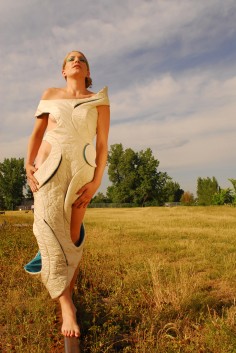Di Mainstone & Joanna Berzowska
Skorpions
LUTTERGILL

source: dimainstone
Skorpions are a set of kinetic electronic garments that move and change on the body in slow, organic motions.
They breathe and pulse, controlled by their own internal programming. They are not “interactive” artifacts insofar as their programming does not respond to simplistic sensor data. They have intentionality; they are programmed to live, to exist, to subsist. They are living behavioral kinetic sculptures that exploit characteristics such as control, anticipation and unpredictability. They have their own personalities, their own fears and desires.
PROCESS
Skoprions is the result of a collaboration between Di Mainstone and Joanna Berzowska of XS Labs in Montreal, Canada. Di worked closely with the XS Labs team to create these kinetic costumes that combine art, fashion, technology and performance. Skorpions integrate electronic fabrics, the shape memory alloy Nitinol, mechanical actuators like magnets, soft electronic circuits, and traditional textile construction techniques. The cut of the pattern, the seams, and other construction details became an important component of engineering design.
Performance
Skorpions have been shown at SIGGRAPH Los Angeles, Boston Science Museum, NIMK Amsterdam, Vancouver 2010 Code Live Olympics. When showcasing these kinetic sculptures, we highlight each of their personalities for the viewer, as each dress was built around a character narrative. Here is an example:
Luttergill is a cocoon about to burst open – as the host, who pupates inside its elegant folds, strives to escape. The quilted shell is constructed with built-in lines of weakness along which the host can tear easily from inside and create exit holes that only allow a one-way passage out. In so doing, the soft shell is slowly coming apart at the seams, breathing, opening, threatening to liberate the beautiful blue silk hidden inside.
.
.
.
.
.
.
.
source: berzowska
SKORPIONS are a set of kinetic electronic garments that move and change on the body in slow, organic motions. They have anthropomorphic qualities and can be imagined as parasites that inhabit the skin of the host. They breathe and pulse, controlled by their own internal programming. They are not “interactive” artifacts insofar as their programming does not respond to simplistic sensor data. They have intentionality; they are programmed to live, to exist, to subsist. They are living behavioral kinetic sculptures that exploit characteristics such as control, anticipation, and unpredictability. They have their own personalities, their own fears and desires.
SKORPIONS integrate electronic fabrics, the shape-memory alloy Nitinol, mechanical actuators such as magnets, soft electronic circuits, and traditional textile construction techniques such as sculptural folds and drapes of fabric across the body. The cut of the pattern, the seams, and other construction details become an important component of engineering design.
SKORPIONS reference the history of garments as instruments of pain and desire. They hurt you and distort your body the same way as corsets and foot binding. They emphasize our lack of control over our garments and our digital technologies. Our clothes shift and change in ways that we do not anticipate. Our electronics malfunction and become obsolete.
SKORPIONS shift and modulate personal and social space by imposing physical constraints on the body. They alter behavior, by hiding or revealing hidden layers, inviting others inside the protective shells of fabric, by erecting breathable walls, or tearing themselves open to divulge hidden secrets.
Joanna Berzowska is Assistant Professor of Design and Computation Arts at Concordia University and a member of the Hexagram Research Institute in Montreal. She is the founder and research director of XS Labs, where her team develops innovative methods and applications in electronic textiles and responsive garments.
Her art and design work has been shown in the Cooper-Hewitt Design Museum in NYC, the V&A in London, the Millenium Museum in Beijing, various SIGGRAPH Art Galleries, ISEA, the Art Directors Club in NYC, the Australian Museum in Sydney, NTT ICC in Tokyo, and Ars Electronica Center in Linz among others.
She lectures internationally about the field of electronic textiles and related social, cultural, aesthetic, and political issues. She was recently selected for the Maclean’s 2006 Honour Roll as one of “thirty nine Canadians who make the world a better place to live in”.
She received her Masters of Science from MIT for her work titled Computational Expressionism and subsequently worked with the Tangible Media Group of the MIT Media Lab and cofounded International Fashion Machines in Boston. She holds a BA in Pure Math and a BFA in Design Arts.
XS Labs is a design research studio with a focus on innovation in the fields of electronic textiles and wearable computing, where we try to break down the traditional boundaries between disciplines. Many of our electronic textile innovations come from the fact that we look at the technical but also cultural history of how textiles have been made for generations (weaving, stitching, embroidery, knitting, beading, quilting) but use materials with different electro-mechanical properties, which enables us to construct more complex textiles with electronic properties.
.
.
.
.
.
.
.
source: youtube
LUTTERGILL is built out of soft quilted cotton with an elegant, cocoon-like silhouette, stitched to mirror the contours of the female form. Several seams slowly roll open and peel apart to reveal and release slices of iridescent color. The movement of these gill-like details is enabled by filaments of shape memory alloy (SMA) stitched into the inside of the fissures. The SMA is controlled through our custom electronics board. LUTTERGILL twists and narrows around the waist, morphing into a belt that encircles the body and is fastened in the front with a bespoke leather clasp. LUTTERGILL is accessorized with a beautiful asymmetric skullcap that shields half of the face and curls around to accentuate the exposed eye.

